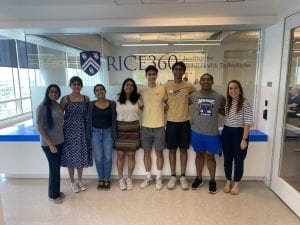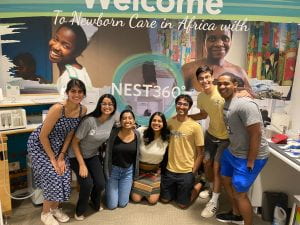Hi everyone, it’s Diya again with a blog!
Wow, the second and third weeks of my internship have already finished. Time seems to be moving so fast perhaps because every single day, working 9-5, has actually been so fun. I genuinely have been looking forward to every new day at work as the progress we have been making on our projects is so exciting and I’m learning so much!
So during the beginning of our second week, I actually joined the SEED team working on the gastric suction project in addition to my breast cancer screening training model project. My teammates for this project are Mina, Parnika, and Precious. Thus our team name is Team PuMPeD! The gastric suction project was previously a capstone engineering design project by Team BellyTubbies. Our goal for this project in the summer was to simplify and strengthen the electronics of the current prototype and design a better form factor for the device.
Here are the work updates on both projects:
- Breast Cancer Screening Training Model: We wrapped a lot of important context research these two weeks and are almost done with our design criteria (need to get them checked with Dr. Taylor before finalizing). After a meeting with our clients from MD Anderson, we decided to work on the CBE screening training model rather than the diagnostic biopsy training model. The clinicians recommended that this model was probably a slightly higher priority for them based on the current needs in target countries. We also decided to have weekly in person meetings with our clinician mentors which would allow Phillip and I to go into their MD Anderson office and show them the models we’ve worked on that week. This would allow them to physically feel the mock tissue of our models and give us feedback. Because how the breast feels is hard to quantify, we resolved as a team that the most effective means of prototyping and iterating would be to get regular in person feedback from the clinicians. Thus we’ve also been working on learning Rhino to create a 3D printed mold for the breast and researching materials we can use to create our initial prototypes. We’ve placed some materials orders and these should be arriving early next week so that we can begin initial prototyping based on our current ideas. Our first in person meeting with the clinicians is on the coming Wednesday!
- Improved Gastric Suction Device: Because I joined the SEED team one week later, I initially just worked on catching up on a lot of the reading and documentation for the project. After we got the previous team’s prototype from Dr. Nejad, we also worked on reassembling the circuitry and tubing in order to better understand the mechanics and electronics of how the device works. This was a really fun learning experience as we got to really “get our hands dirty” working with Arduinos and thinking through the fluid transport logic. After this, we had a big group brainstorming session and began morphing and screening our ideas. Hopefully early next week we can place some materials orders and get to prototyping!
In addition to working on projects, this week also had some other exciting events! As we concluded our orientation for our internship, the Malawi and Tanzania interns took off to their respective countries early this week. All of us showed up to the BRC Monday morning to send off the Malawi interns who were flying out first. We discussed sending each other pictures on updates from work and daily life from the 3 different countries the 7 of us are in this summer. Additionally, some fellow interns from Nigeria actually flew in on Wednesday, so it was very nice to have lunch with them and hear a little about their lives and take them on a campus tour. I’m excited to learn more about them and their experiences and to share mine! Hopefully we can continue to have lunch with them as this gives us some time to interact with them outside of work as well.
Finally, I want to talk about the networking lunch that took place this past Thursday. My table really had some wonderful discussions and I came out of that lunch feeling quite inspired. I learned about the paths that several of the guests took to get to working in Bioengineering or Global Health. This was super interesting to me as these are the fields I am thinking of pursuing as of right now. It also made me realize how unique and special Rice 360 and Nest 360 are and made me feel very grateful for being at Rice and for the opportunity to be an intern with them. As a result of the orientation discussions and this lunch I am sure that I want to work in the field of global health to some degree, both as an undergrad and even sometime in the future. As a result of my two projects – one more Bioengineering and one quite Electrical Engineering, I’ve also realized that I want to take a couple of electrical engineering classes to learn how to do basic circuitry and electronics. In summary, hearing about the field of global health from so many amazing and accomplished professors, mentors, and guests has been very inspiring so far.
Until next week! – Diya

